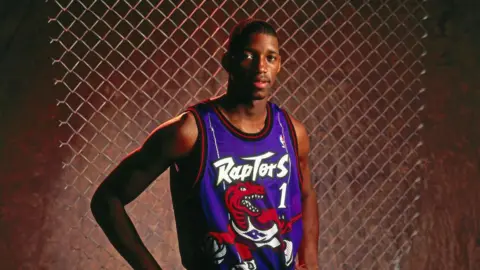 Getty Images
Getty Images“The next great moment in Canadian sports history starts today.”
These remarks were uttered in a video officially announcing that Toronto will be home to the newest franchise of the Women’s National Basketball Association (WNBA).
The launch was celebrated at a news conference in the city on Thursday, attended by Prime Minister Justin Trudeau, Toronto Mayor Olivia Chow, and rap superstar Drake, who is an ambassador for city’s NBA team.
The new franchise will be the WNBA’s 14th – and the league’s first expansion outside of the US.
It is also a monumental moment for women’s sports in the country where the game of basketball was born.
The team, which is set to begin playing in 2026, has yet to be named.
But people are already buzzing about its name and marketing, and what message the team will be sending to Canada and the world with its branding.
On social media one user suggested the Toronto Dragons, which was on the short-list of names for the Raptors.
The Toronto Aurora was floated by CBC reporter Tom Harrington, as a nod to the northern lights.
Others suggested Northstars, or Huskies – the name of a historic basketball team in Toronto that predated the Raptors and disbanded in 1947 after only one season.
Larry Tanenbaum, the Toronto businessman who was awarded city’s WNBA franchise for C$50m ($36.5m; £28.7m), told the Associated Press that the team will take its time in choosing a name, and will “solicit public input”.
For Misty Meeks, a public relations expert at NATIONAL, a Canada-based marketing firm, the team’s name should fit the culture of the time, but also to “grow and evolve over time and continue to stay relevant”.
It should also tap into the significance of being Canada’s first WNBA team, she said.
“You’re not just launching a new team, but you’re rather opening up the playing field for women’s sports in Canada, and that’s a huge endeavour,” Ms Meeks told the BBC.
“It’s about standing for something far more than just a team.”
 Getty Images
Getty ImagesExactly 30 years ago, the city was tasked with naming another, brand new basketball team: the Toronto Raptors.
Tom O’Grady, who was the National Basketball Association (NBA)’s first-ever creative director at the time, recalled it being a “very difficult assignment”.
“You’ve got to remember that (in the early 1990s), the Maple Leafs were a religion in Toronto sports at the time,” he told the BBC, referencing the ice hockey team.
“It was hockey and then everything else.”
The city’s baseball team – the Toronto Blue Jays – was also coming out of two consecutive championship wins.
Because of this, Mr O’Grady said the Raptors’ marketing team focused on carving new ground. They would find a unique name, and outfit their players in a colour that strayed away from the traditional blue worn by the city’s hockey and baseball teams.
They also wanted to appeal to younger fans in the city.
At the time, dinosaurs were all the rage thanks to the 1993 global movie hit Jurassic Park. The Raptors name was born.
“It was perfect for what we were trying to do,” Mr O’Grady said. It appealed to children and positioned the Toronto Raptors as an international brand.
“Everybody loves dinosaurs.”
The marketing team still wanted to put the name to the test and engage fans by holding a contest, where Torontonians were able to vote for their favourite name from a list of 10.
Besides the Raptors, other monikers included Bobcats, Beavers, and Hogs – a nod to Toronto’s “Hogtown” nickname.
Mr O’Grady admitted that a couple of other names did receive more votes than the Raptors.
“But I think people didn’t understand it, there were no pictures or logos (then),” he said.
Many would argue that Mr O’Grady and the NBA made the right call.
While the original purple and red Toronto Raptors jerseys were mocked by some at the time, the team has gone on to become a huge success, winning a championship in 2019 and inspiring a new generation of Canadians to play the sport.
 Getty Images
Getty ImagesMr O’Grady was also instrumental in launching the first original eight WNBA teams.
At the time, the focus was on branding “sister franchises” of the existing men’s basketball teams, he said, as the teams often played in the same arena.
Houston’s WNBA team name became the Comets – inspired by the Houston Rockets, and Sacramento’s team was named the Monarchs, after the Sacramento Kings.
One of the newest WNBA franchises – the Golden State Valkyries – is an apparent riff off the Golden State Warriors, who play in the same arena.
But Mr O’Grady said Toronto’s team has a chance to carve out its own identity, partly because they will play at a different venue from the Raptors – one where the city’s professional women’s hockey team also hosts its games.
“I think you want to make a statement that says: ‘We’re not just the sister team anymore. We’re standing on our own,’” he said.
Thursday’s announcement offered a few clues into the branding direction, as Mr Tanenbaum remarked that the franchise will be “Canada’s team”.
“While our home base will be here in Toronto, we will play games in Vancouver and Montreal throughout the season, uniting the country behind our franchise,” he said.
Whatever name the team chooses, Ms Meeks said she hopes the franchise will be a success embraced both by fans and sponsors.
“I do think that the time is now,” she said.
And with the recent success women’s basketball has seen, Ms Meeks added she has “high hopes that the WNBA will be very well-received” in both Toronto and across the country.





![Bajaj Chetak [2020 – 2024] On Road Price in Eluru – 2024 Chetak [2020](https://nowhyderabad.com/wp-content/uploads/2024/12/1734973795_bajaj-chetak-2025-right-side-view_360x240-100x75.jpg)
